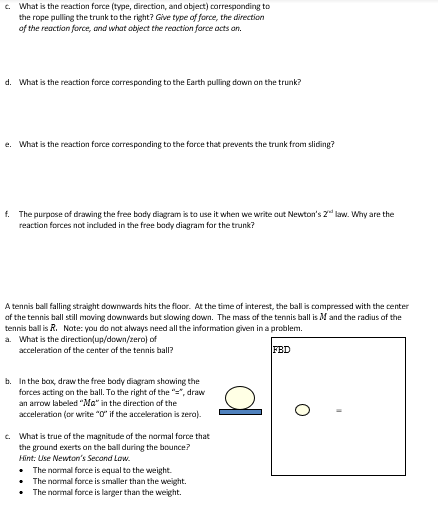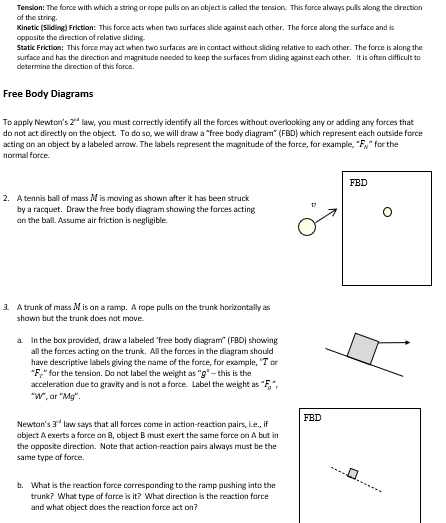A tennis ball of mass M is moving as shown after it has been struck by a racquet. Draw the free body diagram showing the forces acting on the ball. Assume air friction is negligible.
A tennis ball of mass M is moving as shown after it has been struck by a racquet. Draw the free body diagram showing the forces acting on the ball. Assume air friction is negligible.
Glencoe Physics: Principles and Problems, Student Edition
1st Edition
ISBN:9780078807213
Author:Paul W. Zitzewitz
Publisher:Paul W. Zitzewitz
Chapter5: Displacement And Force In Two Dimensions
Section: Chapter Questions
Problem 103A
Related questions
Topic Video
Question

Transcribed Image Text:c. What is the reaction force (type, direction, and object) corresponding to
the rope pulling the trunk to the right? Give type of force, the direction
of the reaction force, and what object the reaction force acts on.
d. What is the reaction force corresponding to the Earth pulling down on the trunk?
e. What is the reaction force corresponding to the force that prevents the trunk from sliding?
f. The purpose of drawing the free body diagram is to use it when we write out Newton's 2 law. Why are the
reaction forces not included in the free body diagram for the trunk?
A tennis ball falling straight downwards hits the floor. At the time of interest, the ball is compressed with the center
of the tennis ball still moving downwards but slowing down. The mass of the tennis ball is M and the radius of the
tennis ball is R. Note: you do not always need all the information given in a problem.
a. What is the direction(up/down/zero) of
acceleration of the center of the tennis ball?
FBD
b. In the bax, draw the free body diagram showing the
forces acting on the ball. To the right of the "-", draw
an arrow labeled "Ma" in the direction of the
acceleration (or write "0" if the acceleration is zero).
c. What is true of the magnitude of the normal force that
the ground exerts on the ball during the bounce?
Hint: Use Newton's Second Law.
• The normal force is equal to the weight.
•
The normal force is smaller than the weight.
The normal force is larger than the weight.

Transcribed Image Text:Tension: The force with which a string or rope pulls on an object is called the tension. This force always pulls along the direction
of the string.
Kinetic (Sliding) Friction: This force acts when two surfaces slide against each other. The force along the surface and is
opposite the direction of relative sliding.
Static Friction: This force may act when two surfaces are in contact without sliding relative to each other. The force is along the
surface and has the direction and magnitude needed to keep the surfaces from sliding against each other. It is often difficult to
determine the direction of this force.
Free Body Diagrams
To apply Newton's 2 law, you must correctly identify all the forces without overlooking any or adding any forces that
do not act directly on the object. To do so, we will draw a "free body diagram" (FBD) which represent each outside force
acting on an object by a labeled arrow. The labels represent the magnitude of the force, for example, "F" for the
normal force.
2. A tennis ball of mass M is moving as shown after it has been struck
by a racquet. Draw the free body diagram showing the forces acting
on the ball. Assume air friction is negligible.
3. A trunk of mass Mis on a ramp. A rope pulls on the trunk horizontally as
shown but the trunk does not move.
a. In the box provided, draw a labeled "free body diagram" (FBD) showing
all the forces acting on the trunk. All the forces in the diagram should
have descriptive labels giving the name of the force, for example, "Tor
"F" for the tension. Do not label the weight as "g" - this is the
acceleration due to gravity and is not a force. Label the weight as "F",
"W", or "Mg".
Newton's 3" law says that all forces come in action-reaction pairs, i.e., if
object A exerts a force on B, object B must exert the same force on A but in
the opposite direction. Note that action-reaction pairs always must be the
same type of force.
b. What is the reaction force corresponding to the ramp pushing into the
trunk? What type of force is it? What direction is the reaction force
and what object does the reaction force act on?
FBD
FBD
Expert Solution
This question has been solved!
Explore an expertly crafted, step-by-step solution for a thorough understanding of key concepts.
Step by step
Solved in 3 steps with 5 images

Knowledge Booster
Learn more about
Need a deep-dive on the concept behind this application? Look no further. Learn more about this topic, physics and related others by exploring similar questions and additional content below.Recommended textbooks for you

Glencoe Physics: Principles and Problems, Student…
Physics
ISBN:
9780078807213
Author:
Paul W. Zitzewitz
Publisher:
Glencoe/McGraw-Hill

University Physics Volume 1
Physics
ISBN:
9781938168277
Author:
William Moebs, Samuel J. Ling, Jeff Sanny
Publisher:
OpenStax - Rice University

College Physics
Physics
ISBN:
9781285737027
Author:
Raymond A. Serway, Chris Vuille
Publisher:
Cengage Learning

Glencoe Physics: Principles and Problems, Student…
Physics
ISBN:
9780078807213
Author:
Paul W. Zitzewitz
Publisher:
Glencoe/McGraw-Hill

University Physics Volume 1
Physics
ISBN:
9781938168277
Author:
William Moebs, Samuel J. Ling, Jeff Sanny
Publisher:
OpenStax - Rice University

College Physics
Physics
ISBN:
9781285737027
Author:
Raymond A. Serway, Chris Vuille
Publisher:
Cengage Learning

College Physics
Physics
ISBN:
9781305952300
Author:
Raymond A. Serway, Chris Vuille
Publisher:
Cengage Learning

Principles of Physics: A Calculus-Based Text
Physics
ISBN:
9781133104261
Author:
Raymond A. Serway, John W. Jewett
Publisher:
Cengage Learning

Physics for Scientists and Engineers, Technology …
Physics
ISBN:
9781305116399
Author:
Raymond A. Serway, John W. Jewett
Publisher:
Cengage Learning